บทนำ : แนะนำ SPC และนิยามศัพท์
แนะนำการควบคุมกระบวนการด้วยหลักการทางสถิติ(Statistical Process Control : SPC) และเว็บไซต์นี้
แนะนำการควบคุมกระบวนการด้วยหลักการทางสถิติ(Statistical Process Control : SPC) และเว็บไซต์นี้
Introduction to Statistical Process Control (SPC) and this website
Statistical Process Control is a combination of techniques aimed at continually improving production processes so that the customer may depend on the uniformity of a product and may purchase it at minimum cost. In this page we will try and provide you with information to understand SPC and give you guidelines how to implement it in a company. This page also has a full training about specific techniques used in SPC.
การควบคุมกระบวนการด้วยหลักการทางสถิติ (Statistical Process Control : SPC) เป็นการรวมกันของเทคนิคที่มุ่งปรับปรุงกระบวนการผลิตอย่างต่อเนื่องเพื่อให้ลูกค้าสามารถได้รับผลิตภัณฑ์ที่เหมือนกันและสามารถซื้อได้ในราคาต่ำที่สุด ในบทนี้เราจะพยายามและให้รายละเอียดคุณเพื่อเข้าใจ SPC และให้แนวทางในการดำเนินการในบริษัท บทนี้ยังมีการฝึกอบรมเต็มรูปแบบเกี่ยวกับเทคนิคเฉพาะที่ใช้ใน SPC
การควบคุมกระบวนการด้วยหลักการทางสถิติ(Statistical Process Control : SPC) มาจากไหน?
Where did Statistical Process Control (SPC) came from?
Statistical Process Control is developed in the 1920’s by Walter Shewart at Bell Telephone Laboratories. It started as an investigation to develop a scientific basis for attaining economic control of quality of manufacturing product through the establishment of control limits to indicate at every stage in the production process from raw materials to finished product when the quality of product is varying more than is economically desirable as Walter Shewart states it in his preface of the book resulting from this investigation.
SPC ได้รับการพัฒนาในปีค.ศ. 1920 โดย Walter Shewart ที่ Bell Telephone Laboratories เริ่มต้นจากการค้นคว้าเพื่อพัฒนาหลักการพื้นฐานทางวิทยาศาสตร์เพื่อบรรลุเป้าหมายของการควบคุมคุณภาพในการผลิตผลิตภัณฑ์ในเชิงเศรษฐศาสตร์ผ่านการกำหนดเส้นควบคุม(Control Limit)เพื่อระบุที่ทุกๆขั้นตอนในกระบวนการผลิตเริ่มจากรับวัตถุดิบจนถึงผลิตภัณฑ์สำเร็จ เมื่อคุณภาพของผลิตภัณฑ์มีความผันแปรมากกว่าที่ต้องการในทางเศรษฐศาสตร์ตามที่ Walter Shewart กล่าวไว้ในคำนำของหนังสือที่ได้จากผลการค้นคว้านี้
The book “Economic Control of Quality of Manufactured Product” was published in 1931 and all concepts described in this book are still valid more than 80 years later. The methods described by Shewart were incorporated into a management philosophy by Dr. W.E. Deming (a younger colleague of Shewhart).
หนังสือ “Economic Control of Quality of Manufactured Product” เผยแพร่ในปี 1931 และแนวคิดทั้งหมดอธิบายไว้ในหนังสือเล่มนี้และยังใช้ได้อยู่มากกว่า 80 ปีแล้ว วิธีการอธิบายโดย Shewart ถูกรวมอยู่ในปรัชญาการจัดการโดย Dr.W.E. Deming (เพื่อนร่วมงานรุ่นน้องของ Shewart)
Just prior to World War II American industrial management did not pay very much attention to Deming and his views on statistical techniques and open management style. However Japan’s post war efforts to increase production, and to compete with western industries, found Deming’s philosophy attractive. Top Japanese management concluded that they had to improve quality, and invited Deming to lecture in Japan in the early 1950’s. The successful tour lead to a few companies implementing the Deming methodologies and within a few months their quality and productivity increased. This in turn led to a greater proliferation of these techniques in Japan. It was the commitment of top Japanese management, the realization of the rewards of SPC implementation plus the philosophies of Deming that are the basis of Japanese competitive advantage as we know it today. Deming stated that a quality product can only be made if all the processes in a company are under control, therefore everybody in a company is responsible for quality. The knowledge on the shop floor has to be used and the walls between departments have to be torn down. It is the responsibility of management to allow operators to work with the best methods, the best machines, etc. In 1981 Deming appeared in a documentary on American television named: “If Japan can, why can’t we?” There was a considerable reaction and for the first time managers in America listened to his philosophy. It was quickly proven that SPC could also give beneficial results in western industries. However despite increased attention on this side of the globe SPC is still in a preliminary implementation stage. Deming has summarized his philosophy in 14 rules of management. These rules are given below:
ก่อนสงครามโลกครั้งที่ 2 การจัดการอุตสาหกรรมของอเมริกาไม่ได้ให้ความสนใจกับ Deming มากนักและมุมมองของเขาเกี่ยวกับเทคนิคทางสถิติและรูปแบบการจัดการแบบเปิด อย่างไรก็ตามความพยายามหลังสงครามของญี่ปุ่นในการเพิ่มการผลิตและเพื่อแข่งขันกับอุตสาหกรรมตะวันตกพบว่าปรัชญาของ Deming นั้นน่าสนใจ ผู้บริหารระดับสูงของญี่ปุ่นสรุปว่าพวกเขาต้องปรับปรุงคุณภาพและเชิญ Deming ไปบรรยายที่ญี่ปุ่นในช่วงต้นทศวรรษ 1950 การตระเวนบรรยายถึงความสำเร็จนำไปสู่บริษัทเพียงไม่กี่แห่งที่ใช้วิธีการ Deming และภายในไม่กี่เดือนคุณภาพและผลผลิตของพวกเขาก็เพิ่มขึ้น ซึ่งส่งผลให้เทคนิคเหล่านี้แพร่หลายมากขึ้นในญี่ปุ่น กลายเป็นพันธกิจของผู้บริหารระดับสูงของญี่ปุ่นที่มีการตระหนักถึงผลตอบแทนของการใช้ SPC บวกกับปรัชญาของ Deming ที่เป็นพื้นฐานของความได้เปรียบในการแข่งขันของญี่ปุ่นอย่างที่เรารู้กันในปัจจุบัน Deming กล่าวว่าผลิตภัณฑ์ที่มีคุณภาพจะเกิดขึ้นได้ก็ต่อเมื่อกระบวนการทั้งหมดในบริษัทอยู่ภายใต้การควบคุม ดังนั้นทุกคนในบริษัทต้องรับผิดชอบต่อคุณภาพ ต้องใช้ความรู้หน้างาน(shop floor) และทลายกำแพงระหว่างแผนกลง เป็นความรับผิดชอบของฝ่ายบริหารเพื่อให้ผู้ปฏิบัติงานสามารถทำงานด้วยวิธีการที่ดีที่สุด,เครื่องจักรที่ดีที่สุด เป็นต้นในปี 1981 Deming ได้ปรากฏตัวในสารคดีทางโทรทัศน์ของอเมริกาชื่อ : “If Japan can, why can’t we?” ได้รับการตอบรับอย่างมากและเป็นครั้งแรกที่ผู้จัดการในอเมริกาฟังปรัชญาของเขา ได้รับการยอมรับอย่างรวดเร็วว่า SPC สามารถให้ผลลัพธ์ที่เป็นประโยชน์ในอุตสาหกรรมตะวันตกได้เช่นกัน อย่างไรก็ตามแม้จะมีความสนใจในด้านนี้เพิ่มขึ้นทั่วโลก แต่ SPC ก็ยังอยู่ในขั้นตอนการดำเนินการในช่วงเริ่มต้น Deming ได้สรุปปรัชญาของเขาไว้ในกฎ 14 ข้อในการบริหาร ดังนี้ :
- Create constancy of purpose toward improvement of product and service with the aim to become competitive, stay in business and provide jobs. สร้างจุดมุ่งหมายในการปรับปรุงผลิตภัณฑ์และบริการโดยมีจุดมุ่งหมายเพื่อให้สามารถแข่งขันได้อยู่ในธุรกิจและจัดหางาน
- Adopt the new philosophy. We are in a new economic age, created by Japan. A transformation of Western style of management is necessary to halt the continued decline of industry. รับเอาปรัชญาใหม่มาใช้ เราอยู่ในยุคเศรษฐกิจใหม่ที่ญี่ปุ่นสร้างขึ้น การเปลี่ยนแปลงรูปแบบการจัดการแบบตะวันตกเป็นสิ่งจำเป็นเพื่อยับยั้งการเสื่อมลงอย่างต่อเนื่องของอุตสาหกรรม
- Cease dependence on inspection to achieve quality. Eliminate the need for mass inspection by building quality into the product in the first place. ยุติการพึ่งพาการตรวจสอบเพื่อให้ได้คุณภาพ ขจัดความจำเป็นในการตรวจสอบจำนวนมากด้วยการสร้างคุณภาพให้กับผลิตภัณฑ์ตั้งแต่แรก
- End the practice of awarding business on the basis of price. Purchasing, design, manufacturing and sales departments must work with the chosen suppliers so as to minimize total cost, not initial cost.ยุติแนวทางปฏิบัติในการตัดสินธุรกิจโดยพิจารณาจากราคา ฝ่ายจัดซื้อ, ฝ่ายออกแบบ,ฝ่ายผลิตและฝ่ายขายต้องทำงานร่วมกับผู้จัดส่ง(Supplier)ที่เลือกเพื่อลดต้นทุนรวมไม่ใช่ต้นทุนเริ่มต้น
- Improve constantly, and forever, every activity in the company so as to improve quality and productivity and thus constantly decrease costs. ปรับปรุงทุกกิจกรรมในบริษัท อย่างต่อเนื่องและตลอดไปเพื่อปรับปรุงคุณภาพและผลผลิตและลดต้นทุนอย่างต่อเนื่อง
- Institute education and training on the job, including management.สถาบันการศึกษาและการฝึกอบรมในงาน(on the job) รวมถึงการบริหารจัดการ
- Institute improved supervision. The aim of supervision should be to help people and machines do a better job.สถาบันปรับปรุงการกำกับดูแล จุดมุ่งหมายของการกำกับดูแลควร เพื่อช่วยให้คนและเครื่องจักรทำงานได้ดีขึ้น
- Drive out fear so that everyone may work effectively for the company. ขับไล่ความกลัวออกไปเพื่อให้ทุกคนทำงานให้กับบริษัทได้อย่างมีประสิทธิผล
- Break down the barriers between departments. People in research, design, sales and production must work as a team to tackle production and usage problems that may be encountered with the product or service.ทำลายอุปสรรคระหว่างแผนก บุคลากรในฝ่ายวิจัย,ฝ่ายออกแบบ,ฝ่ายขายและฝ่ายผลิตต้องทำงานเป็นทีมเพื่อจัดการกับปัญหาการผลิตและปัญหาการใช้งานที่อาจพบกับผลิตภัณฑ์หรือบริการ
- Eliminate slogans, exhortations and targets for the workforce asking for new levels of productivity and zero defects. The bulk of the causes of low quality and low productivity belong to the system and will not be in the direct control of the workforce. ขจัดคำขวัญ คำตักเตือนและเป้าหมายสำหรับพนักงานที่ขอให้มีการผลิตในระดับใหม่และไม่มีข้อบกพร่อง สาเหตุส่วนใหญ่ของคุณภาพต่ำและผลผลิตต่ำมาจากระบบและไม่ได้อยู่ในการควบคุมโดยตรงของพนักงาน
- Eliminate work standards that prescribe numerical quotas. Instead, use resources and supportive supervision, using the methods to be described for the job.ขจัดมาตรฐานการทำงานที่กำหนดโควต้าตัวเลข แต่ให้ใช้ทรัพยากรและการกำกับดูแลที่สนับสนุน,วิธีการที่อธิบายไว้ในการทำงานแทน
- Remove the barriers that rob the hourly worker of the right to pride of workmanship. The responsibility of supervision must be changed from sheer numbers to quality. Equally, remove barriers that rob people in management and engineering of their right to pride of workmanship.ขจัดอุปสรรคที่ทำลายสิทธิในความภาคภูมิใจในฝีมือของคนงานรายชั่วโมง ความรับผิดชอบในการกำกับดูแลจะต้องเปลี่ยนจากตัวเลขที่แท้จริงไปสู่คุณภาพ ขจัดอุปสรรคที่ขัดขวางผู้คนในด้านการจัดการและวิศวกรรมอย่างเท่าเทียมกันเพื่อให้พวกเขามีความภาคภูมิใจในผลงาน
- Institute a vigorous program of education and retraining. New skills are required for changes in techniques, materials and services.จัดโปรแกรมการศึกษาและการฝึกอบรมที่เข้มแข็ง จำเป็นต้องมีทักษะใหม่สำหรับการเปลี่ยนแปลงด้านเทคนิค วัสดุและบริการ
- Put everybody in the organization to work in teams to accomplish the transformation.ให้ทุกคนในองค์กรทำงานเป็นทีมเพื่อให้การเปลี่ยนแปลงบรรลุผลสำเร็จ
ความหมายและองค์กรของการควบคุมกระบวนการด้วยหลักการทางสถิติ (SPC)
Definition and Organization of Statistical Process Control(SPC)
มีแนวคิดที่แตกต่างกันมากมายเกี่ยวกับ SPC คืออะไร บางคนมองว่า SPC เป็นการใช้แผนภูมิควบคุมในการวิเคราะห์ข้อมูล บางคนมองว่าเป็นระบบการจัดการที่สมบูรณ์ที่ใช้ในการปรับปรุงคุณภาพและผลผลิตอย่างต่อเนื่อง เรามองว่า SPC เป็นระบบการจัดการที่สมบูรณ์เพื่อปรับปรุงคุณภาพและผลผลิตอย่างต่อเนื่องเพราะนั่นคือเป้าหมายสูงสุดของ SPC คล้ายกับ Six Sigma มาก แต่มีอย่างหนึ่งที่แตกต่างกัน Six sigma ไม่ได้คำนึงถึงการนำไปใช้งานและการวิเคราะห์จะต้องทำให้ได้ประสิทธิภาพมากๆ ในการดำเนินการที่ดีคุณต้องใช้ Real-time SPC เพื่อดำเนินการปรับปรุงอย่างต่อเนื่องอย่างมีประสิทธิภาพ
One of the first requirements to get maximum results is that SPC should be implemented in every level in the organization. To control a process we need to apply SPC real-time. When we measure we need to register the data immediately and plot the results in a control charts. When the process is out of control we need to find the root cause of the out of control and take corrective actions. It makes no sense to only analyze the data at the end of the day because then we can only report about the quality produced and the fact that the process is not in control. It is often too late to get proper information about the root cause take corrective actions. We call this the control level.
หนึ่งในข้อกำหนดแรกเพื่อให้ได้ผลลัพธ์สูงสุดคือควรนำ SPC ไปใช้ในทุกระดับในองค์กร ในการควบคุมกระบวนการเราจำเป็นต้องใช้ Real-time SPC เมื่อเราวัดเราจำเป็นต้องบันทึกข้อมูลทันทีและพล็อตผลลัพธ์ในแผนภูมิควบคุม เมื่อกระบวนการไม่อยู่ในการควบคุมเราจำเป็นต้องหาสาเหตุที่แท้จริงว่าเหตุใดกระบวนการถึงไม่อยู่ในการควบคุมและดำเนินการแก้ไข ไม่มีเหตุผลที่จะวิเคราะห์ข้อมูลในตอนท้ายของวันเท่านั้นเนื่องจากเราสามารถรายงานเกี่ยวกับคุณภาพที่ผลิตได้เท่านั้นและข้อเท็จจริงที่ว่ากระบวนการไม่ได้อยู่ในการควบคุม มักจะสายเกินไปที่จะได้รับข้อมูลที่ถูกต้องเกี่ยวกับสาเหตุที่แท้จริงและดำเนินการแก้ไข เราเรียกสิ่งนี้ว่าระดับการควบคุม

Operators should be empowered to find the root cause and take corrective actions. If they are no capable of finding the root cause or are not allowed to make the required corrective actions. They should inform the production support level (engineers, production management or maintenance) and they have the responsibility to improve the process inputs and provide feedback to the operators how the process is improved. We call this the improvement level. Production management needs to set targets for continual improvement so priorities can be set. They also should provide the means to improve the production factors. We call this the planning level.
ผู้ปฏิบัติงานควรได้รับอำนาจในการค้นหาสาเหตุที่แท้จริงและดำเนินการแก้ไข หากพวกเขาไม่สามารถค้นหาสาเหตุที่แท้จริงหรือไม่ได้รับอนุญาตให้ดำเนินการแก้ไขที่จำเป็น พวกเขาควรแจ้งฝ่ายสนับสนุนการผลิต (วิศวกรการจัดการการผลิตหรือการบำรุงรักษา) และพวกเขามีความรับผิดชอบในการปรับปรุงปัจจัยการผลิตของกระบวนการและให้ข้อเสนอแนะแก่ผู้ปฏิบัติงานว่าจะปรับปรุงกระบวนการอย่างไร เราเรียกสิ่งนี้ว่าระดับการปรับปรุง การจัดการการผลิตจำเป็นต้องกำหนดเป้าหมายสำหรับการปรับปรุงอย่างต่อเนื่องเพื่อให้สามารถกำหนดลำดับความสำคัญได้ นอกจากนี้ยังควรจัดหาวิธีการปรับปรุงปัจจัยการผลิต เราเรียกสิ่งนี้ว่าระดับการวางแผน
If SPC is implemented like described you might get maximum results from your SPC or six sigma implementation.หากใช้ SPC ตามที่อธิบายไว้คุณอาจได้รับผลลัพธ์สูงสุดจากการใช้งาน SPC หรือการดำเนินการ Six Sigma ของคุณ
